2014 NISSAN LEAF belt
[x] Cancel search: beltPage 3 of 397
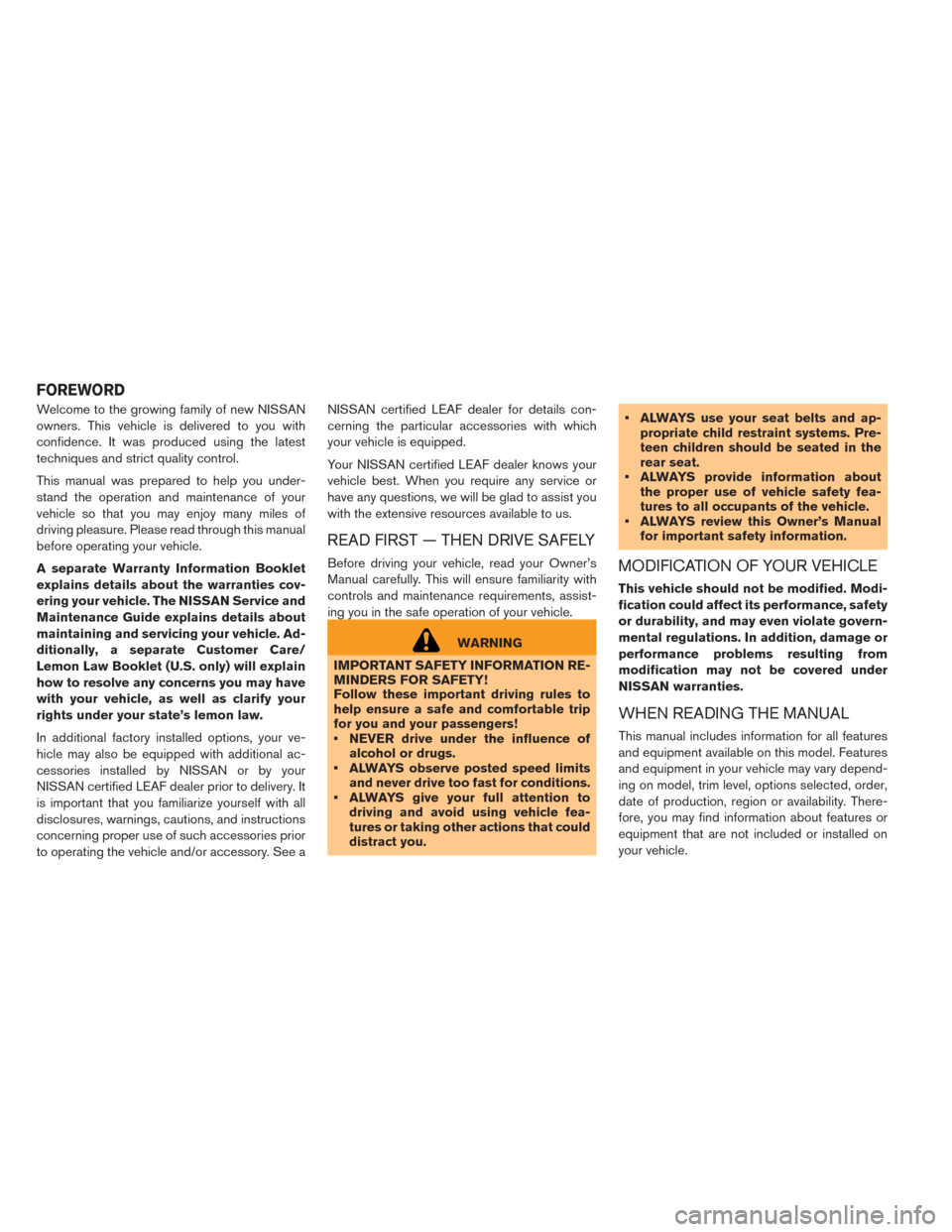
Welcome to the growing family of new NISSAN
owners. This vehicle is delivered to you with
confidence. It was produced using the latest
techniques and strict quality control.
This manual was prepared to help you under-
stand the operation and maintenance of your
vehicle so that you may enjoy many miles of
driving pleasure. Please read through this manual
before operating your vehicle.
A separate Warranty Information Booklet
explains details about the warranties cov-
ering your vehicle. The NISSAN Service and
Maintenance Guide explains details about
maintaining and servicing your vehicle. Ad-
ditionally, a separate Customer Care/
Lemon Law Booklet (U.S. only) will explain
how to resolve any concerns you may have
with your vehicle, as well as clarify your
rights under your state’s lemon law.
In additional factory installed options, your ve-
hicle may also be equipped with additional ac-
cessories installed by NISSAN or by your
NISSAN certified LEAF dealer prior to delivery. It
is important that you familiarize yourself with all
disclosures, warnings, cautions, and instructions
concerning proper use of such accessories prior
to operating the vehicle and/or accessory. See aNISSAN certified LEAF dealer for details con-
cerning the particular accessories with which
your vehicle is equipped.
Your NISSAN certified LEAF dealer knows your
vehicle best. When you require any service or
have any questions, we will be glad to assist you
with the extensive resources available to us.
READ FIRST — THEN DRIVE SAFELY
Before driving your vehicle, read your Owner’s
Manual carefully. This will ensure familiarity with
controls and maintenance requirements, assist-
ing you in the safe operation of your vehicle.
WARNING
IMPORTANT SAFETY INFORMATION RE-
MINDERS FOR SAFETY!
Follow these important driving rules to
help ensure a safe and comfortable trip
for you and your passengers!
• NEVER drive under the influence of
alcohol or drugs.
• ALWAYS observe posted speed limits
and never drive too fast for conditions.
• ALWAYS give your full attention to
driving and avoid using vehicle fea-
tures or taking other actions that could
distract you.• ALWAYS use your seat belts and ap-
propriate child restraint systems. Pre-
teen children should be seated in the
rear seat.
• ALWAYS provide information about
the proper use of vehicle safety fea-
tures to all occupants of the vehicle.
• ALWAYS review this Owner’s Manual
for important safety information.
MODIFICATION OF YOUR VEHICLE
This vehicle should not be modified. Modi-
fication could affect its performance, safety
or durability, and may even violate govern-
mental regulations. In addition, damage or
performance problems resulting from
modification may not be covered under
NISSAN warranties.
WHEN READING THE MANUAL
This manual includes information for all features
and equipment available on this model. Features
and equipment in your vehicle may vary depend-
ing on model, trim level, options selected, order,
date of production, region or availability. There-
fore, you may find information about features or
equipment that are not included or installed on
your vehicle.
FOREWORD
Page 7 of 397
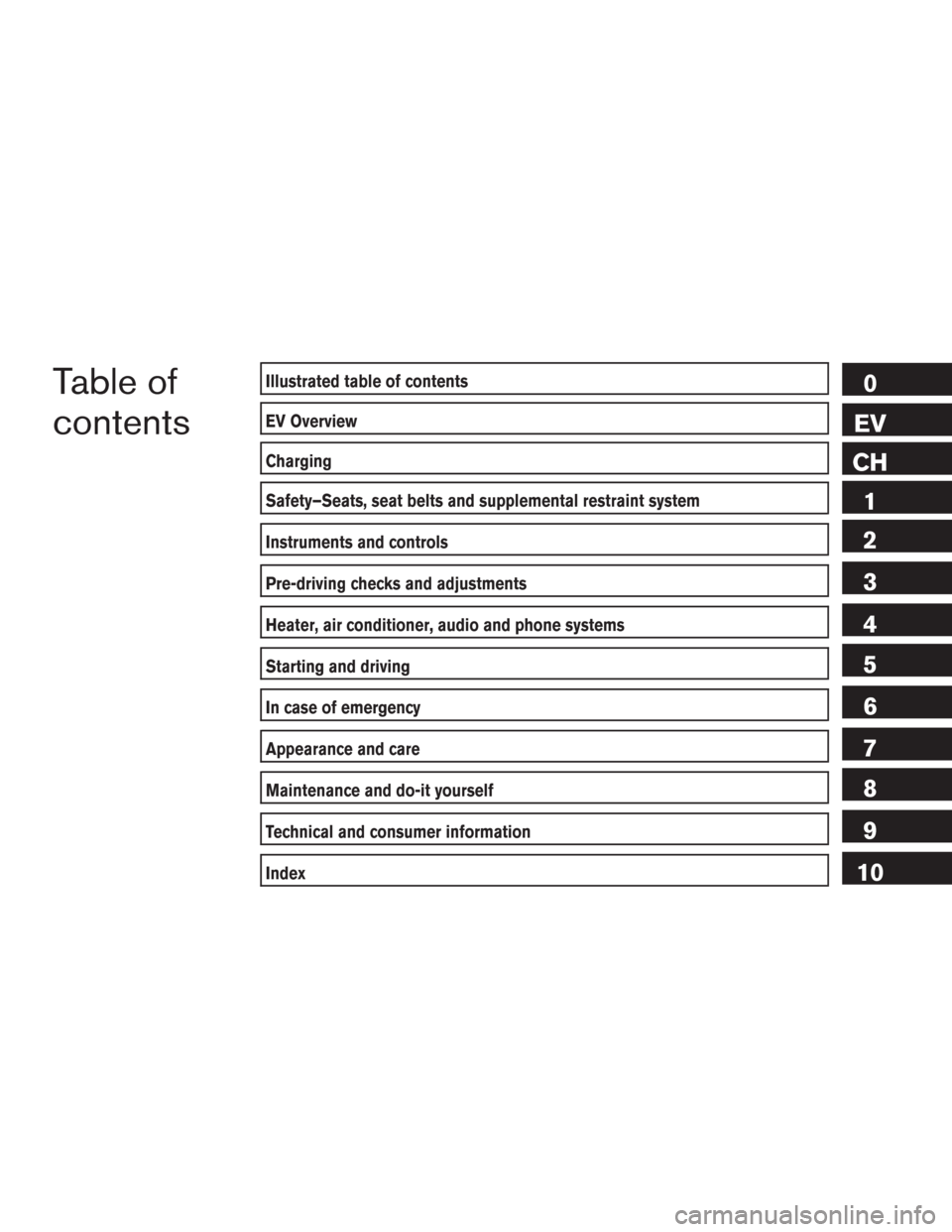
Table of
contentsIllustrated table of contents
EV Overview
Charging
Safety–Seats, seat belts and supplemental restraint system
Instruments and controls
Pre-driving checks and adjustments
Heater, air conditioner, audio and phone systems
Starting and driving
In case of emergency
Appearance and care
Maintenance and do-it yourself
Technical and consumer information
Index
0
EV
CH
1
2
3
4
5
6
7
8
9
10
Page 9 of 397
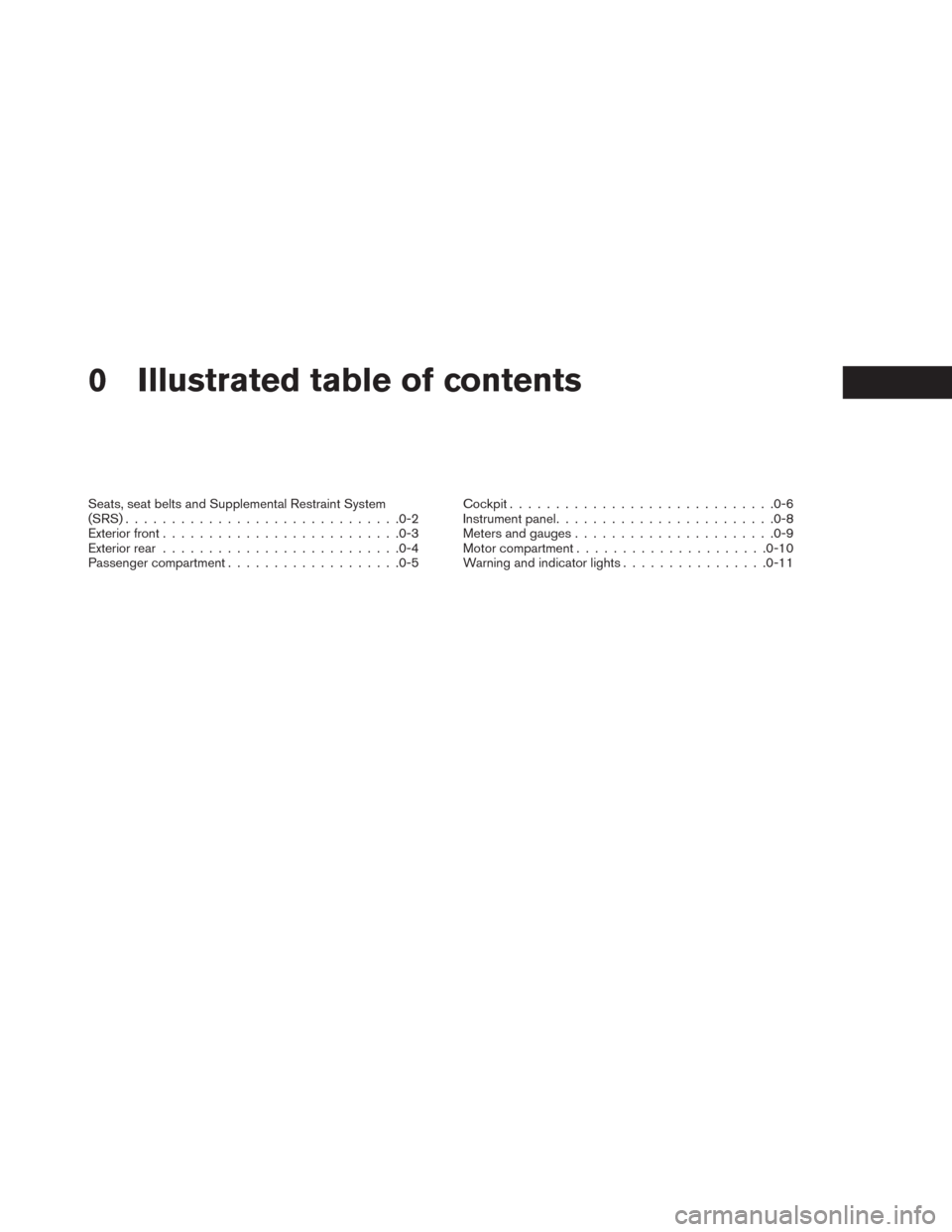
0 Illustrated table of contents
Seats, seat belts and Supplemental Restraint System
(SRS)..............................0-2
Exterior front..........................0-3
Exterior rear..........................0-4
Passenger compartment...................0-5Cockpit.............................0-6
Instrument panel........................0-8
Meters and gauges......................0-9
Motor compartment.....................0-10
Warning and indicator lights................0-11
Page 10 of 397
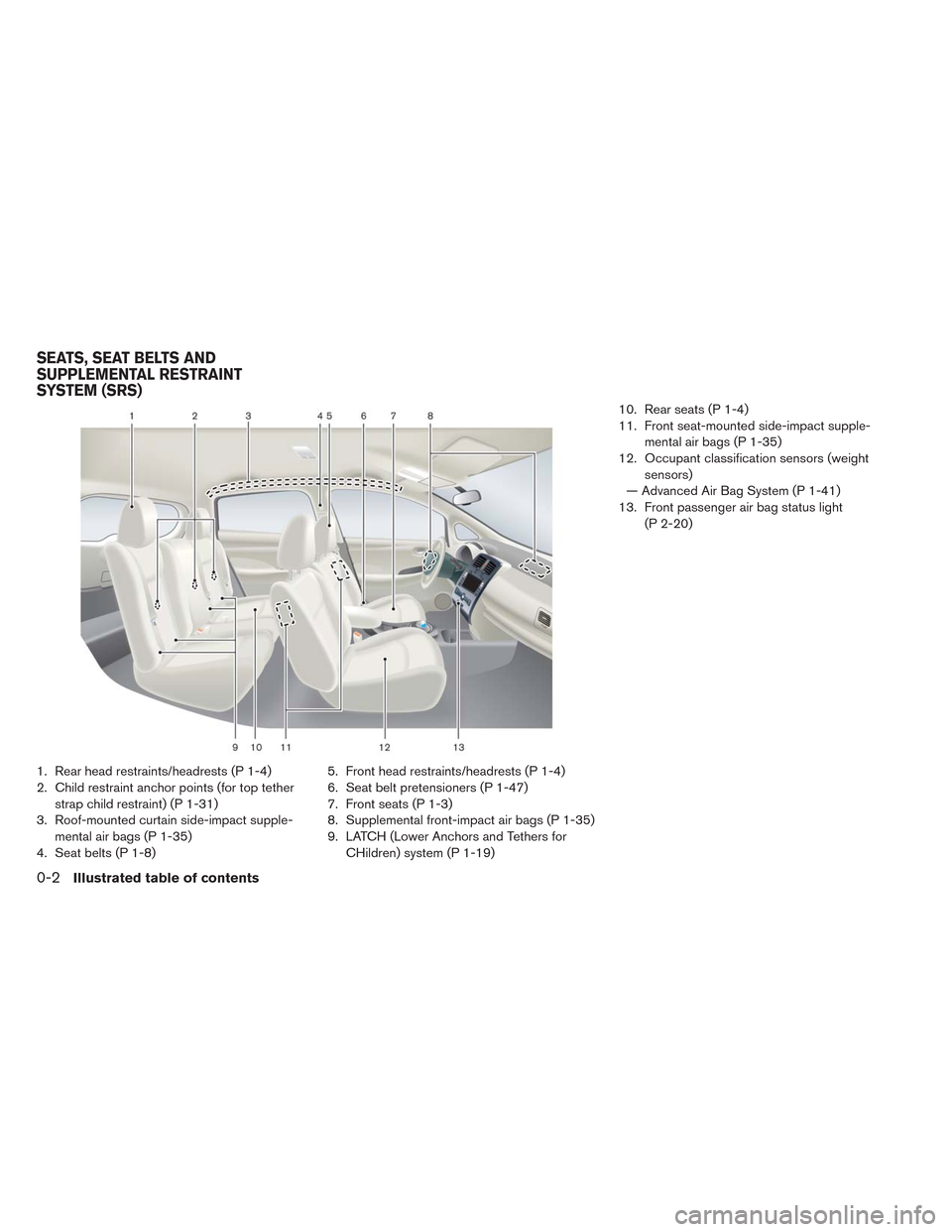
1. Rear head restraints/headrests (P 1-4)
2. Child restraint anchor points (for top tether
strap child restraint) (P 1-31)
3. Roof-mounted curtain side-impact supple-
mental air bags (P 1-35)
4. Seat belts (P 1-8)5. Front head restraints/headrests (P 1-4)
6. Seat belt pretensioners (P 1-47)
7. Front seats (P 1-3)
8. Supplemental front-impact air bags (P 1-35)
9. LATCH (Lower Anchors and Tethers for
CHildren) system (P 1-19)10. Rear seats (P 1-4)
11. Front seat-mounted side-impact supple-
mental air bags (P 1-35)
12. Occupant classification sensors (weight
sensors)
— Advanced Air Bag System (P 1-41)
13. Front passenger air bag status light
(P 2-20)
SEATS, SEAT BELTS AND
SUPPLEMENTAL RESTRAINT
SYSTEM (SRS)
0-2Illustrated table of contents
Page 19 of 397
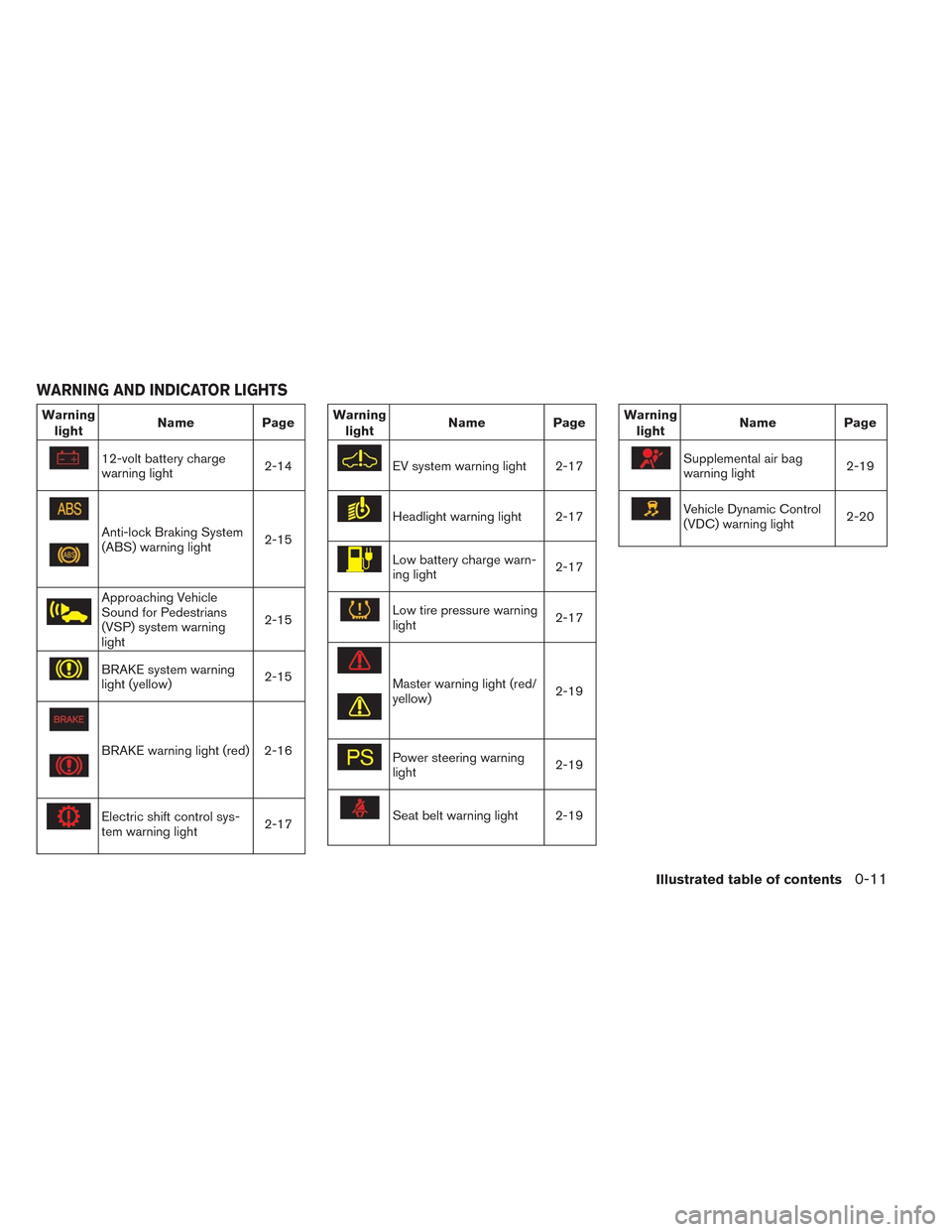
Warning
lightName Page
12-volt battery charge
warning light2-14
Anti-lock Braking System
(ABS) warning light2-15
Approaching Vehicle
Sound for Pedestrians
(VSP) system warning
light2-15
BRAKE system warning
light (yellow)2-15
BRAKE warning light (red) 2-16
Electric shift control sys-
tem warning light2-17
Warning
lightName Page
EV system warning light 2-17
Headlight warning light 2-17
Low battery charge warn-
ing light2-17
Low tire pressure warning
light2-17
Master warning light (red/
yellow)2-19
Power steering warning
light2-19
Seat belt warning light 2-19
Warning
lightName Page
Supplemental air bag
warning light2-19
Vehicle Dynamic Control
(VDC) warning light2-20
WARNING AND INDICATOR LIGHTS
Illustrated table of contents0-11
Page 53 of 397
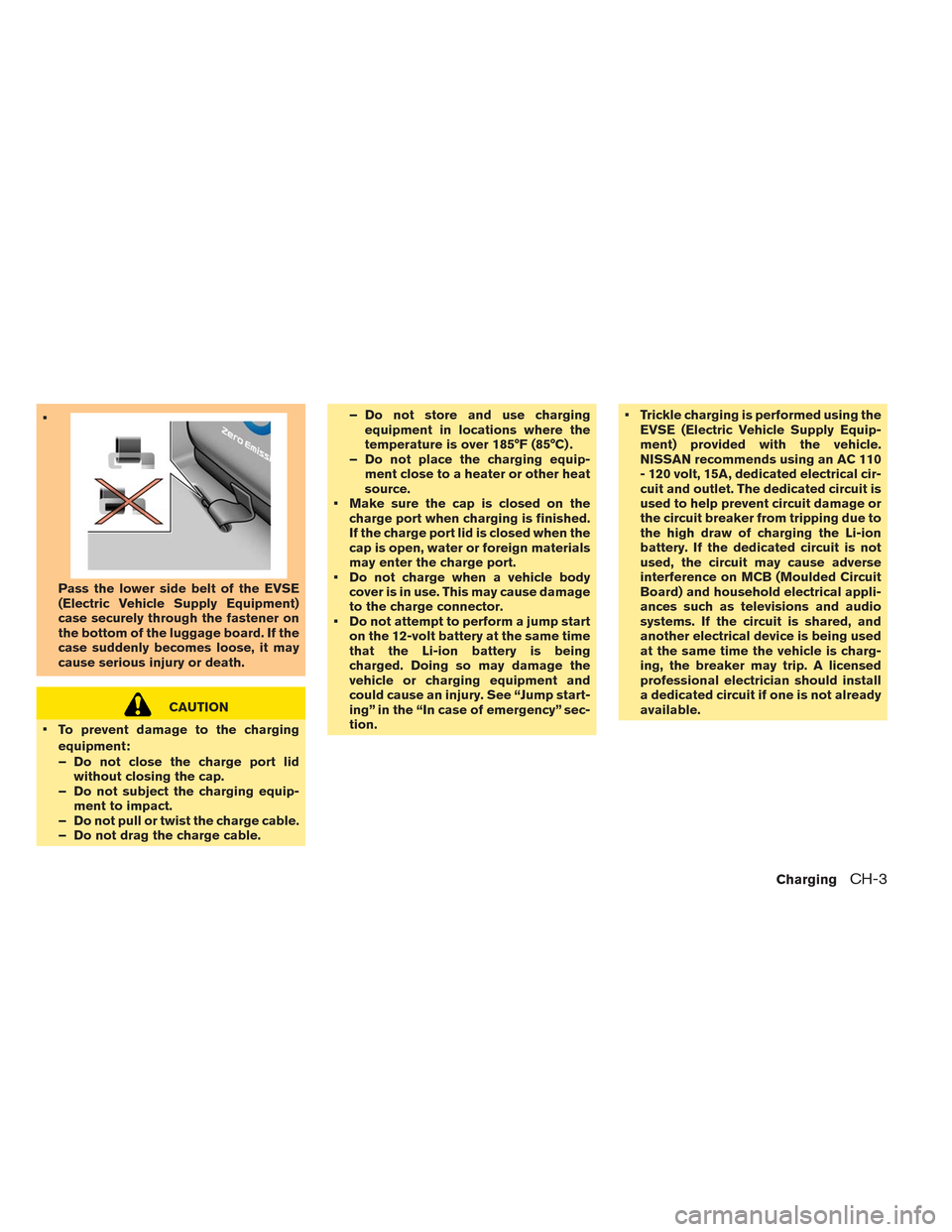
•
Pass the lower side belt of the EVSE
(Electric Vehicle Supply Equipment)
case securely through the fastener on
the bottom of the luggage board. If the
case suddenly becomes loose, it may
cause serious injury or death.
CAUTION
•
To prevent damage to the charging
equipment:
– Do not close the charge port lid
without closing the cap.
– Do not subject the charging equip-
ment to impact.
– Do not pull or twist the charge cable.
– Do not drag the charge cable.– Do not store and use charging
equipment in locations where the
temperature is over 185°F (85°C) .
– Do not place the charging equip-
ment close to a heater or other heat
source.
• Make sure the cap is closed on the
charge port when charging is finished.
If the charge port lid is closed when the
cap is open, water or foreign materials
may enter the charge port.
• Do not charge when a vehicle body
cover is in use. This may cause damage
to the charge connector.
• Do not attempt to perform a jump start
on the 12-volt battery at the same time
that the Li-ion battery is being
charged. Doing so may damage the
vehicle or charging equipment and
could cause an injury. See “Jump start-
ing” in the “In case of emergency” sec-
tion.• Trickle charging is performed using the
EVSE (Electric Vehicle Supply Equip-
ment) provided with the vehicle.
NISSAN recommends using an AC 110
- 120 volt, 15A, dedicated electrical cir-
cuit and outlet. The dedicated circuit is
used to help prevent circuit damage or
the circuit breaker from tripping due to
the high draw of charging the Li-ion
battery. If the dedicated circuit is not
used, the circuit may cause adverse
interference on MCB (Moulded Circuit
Board) and household electrical appli-
ances such as televisions and audio
systems. If the circuit is shared, and
another electrical device is being used
at the same time the vehicle is charg-
ing, the breaker may trip. A licensed
professional electrician should install
a dedicated circuit if one is not already
available.
ChargingCH-3
Page 62 of 397
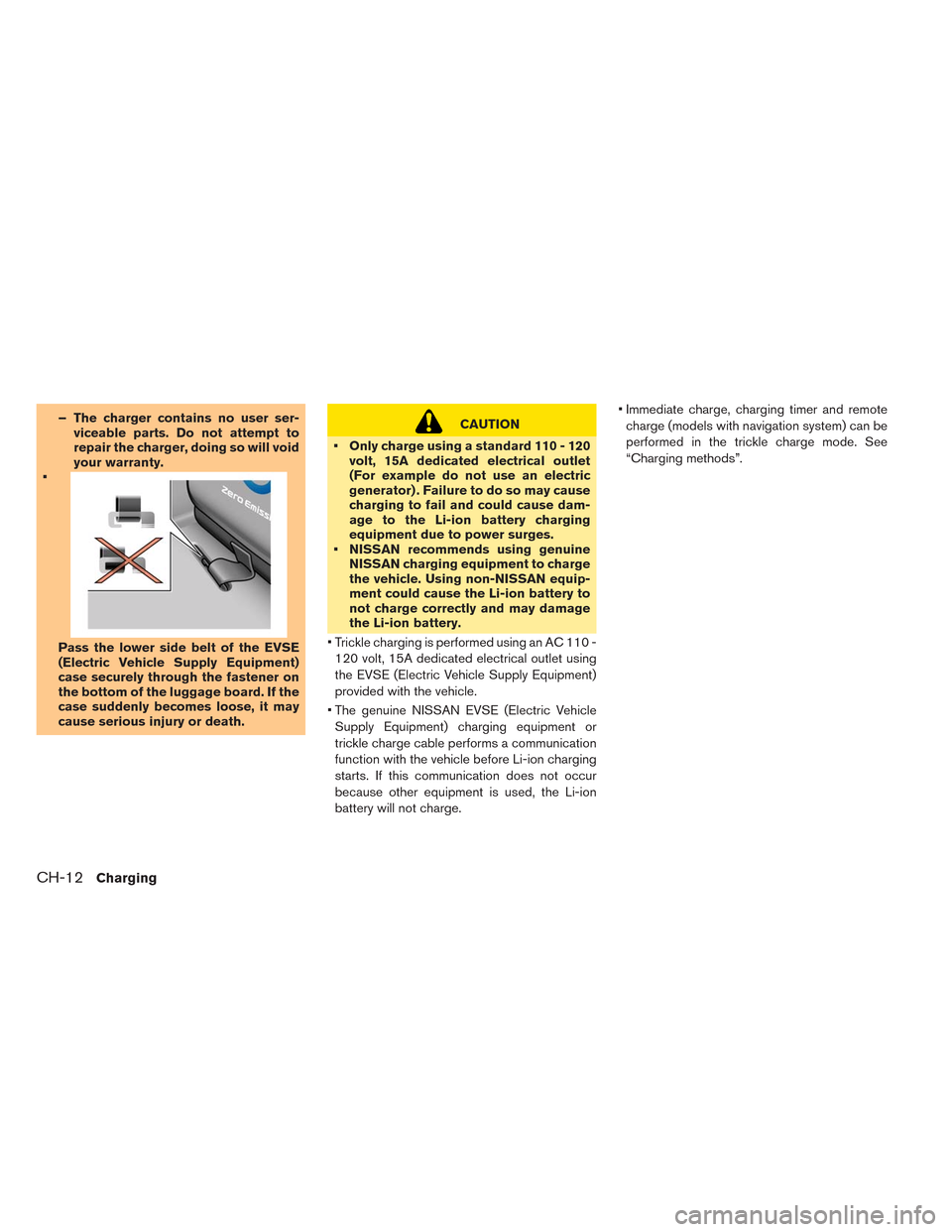
– The charger contains no user ser-
viceable parts. Do not attempt to
repair the charger, doing so will void
your warranty.
•
Pass the lower side belt of the EVSE
(Electric Vehicle Supply Equipment)
case securely through the fastener on
the bottom of the luggage board. If the
case suddenly becomes loose, it may
cause serious injury or death.
CAUTION
• Only charge using a standard 110 - 120
volt, 15A dedicated electrical outlet
(For example do not use an electric
generator) . Failure to do so may cause
charging to fail and could cause dam-
age to the Li-ion battery charging
equipment due to power surges.
• NISSAN recommends using genuine
NISSAN charging equipment to charge
the vehicle. Using non-NISSAN equip-
ment could cause the Li-ion battery to
not charge correctly and may damage
the Li-ion battery.
• Trickle charging is performed using an AC 110 -
120 volt, 15A dedicated electrical outlet using
the EVSE (Electric Vehicle Supply Equipment)
provided with the vehicle.
• The genuine NISSAN EVSE (Electric Vehicle
Supply Equipment) charging equipment or
trickle charge cable performs a communication
function with the vehicle before Li-ion charging
starts. If this communication does not occur
because other equipment is used, the Li-ion
battery will not charge.• Immediate charge, charging timer and remote
charge (models with navigation system) can be
performed in the trickle charge mode. See
“Charging methods”.
CH-12Charging
Page 65 of 397

5. Store in its case.
NOTE:
Perform the following procedure to
store the EVSE (Electric Vehicle Supply
Equipment) in the case.
a. Wind the charge cable into a size that
will allow it to be stored in the case
(approximately 9.8 in (250 mm) in
diameter) .
b. Place the EVSE (Electric Vehicle Sup-
ply Equipment) control box into the
back of the case.
c. Place the charge cable and charge
connector into the case in front of theEVSE (Electric Vehicle Supply Equip-
ment) control box.
WARNING
Pass the lower side belt of the EVSE
(Electric Vehicle Supply Equipment) case
securely through the fastener on the bot-
tom of the luggage board. If the case
suddenly becomes loose, it may cause
serious injury or death.
6. After closing the cap on the charge port, close
the charge port lid.
NOTE:
To stop charging mid-charge, remove the
charge connector. Charging automatically
stops.
HOW TO QUICK CHARGE (IF SO
EQUIPPED)
Quick charge uses public charging stations (up
to 50 kW of power) to charge the battery in a
short period of time.
WARNING
• Always use a quick charger that is
compatible with the LEAF. Using an
incompatible quick charger may cause
a fire or malfunction resulting in seri-
ous personal injury or death.
• Before starting the quick charge, care-
fully read the instructions provided on
the quick charger and make sure the
quick charge connector is properly
connected and locked. Failure to con-
nector or operate the quick charger
correctly could cause damage to the
vehicle or the charging equipment.
NOTE:
Quick charging is possible (even several
times a day) if the battery temperature is
not near the red zone. If the battery tem-
perature reaches the red zone, in order to
protect the battery, quick charging is not
allowed and the power limitation mode will
be triggered.
ChargingCH-15